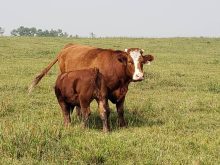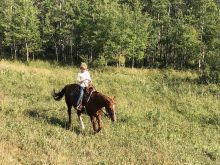Warm temperatures and lots of rain right into fall regenerated pastures producing plenty of nutritious grasses for cattle. Many gestating cows are going into the winter, healthy and in decent shape. By feeding them well-balanced overwintering diets, we can continue this momentum, so these beef cows can get through a typical cold winter and be prepared for a successful calving season.
As a university student I saw firsthand what happens to beef cows left to their own devices, relying only on good body condition without being properly fed. Our class visited a 200-Charolais beef cow herd in the Interlake region of Manitoba. It was early November and I remember most of the cows had a good body cover of fat, but were fed a lot of barley straw in bale feeders.
Read Also

Harvest wraps up and fall work begins
At the Eppich famly ranch in western Saskatchewan, the fall harvest was successful with few breakdowns, cows and calves have been sorted and a new tractor has arrived
For reasons I don’t remember, I returned in late January with a smaller group of students and our animal science professor. To our amazement, some of the same cows were literal skeletons. The owner complained to my professor that he had a number of sick cows and was afraid that he would have to “pull” a lot of newborn calves.
Most likely my professor had given this person good overwinter feeding advice on our first visit that was not followed. My professor’s research had demonstrated over the years the importance of cows receiving the necessary supplemental feed during winter to maintain good body condition up to calving. He knew the downside. Proper feeding is also rewarded with good calving ease, high quality and plenty of colostrum. Later-on cows are quick to return to fertile estrus. These benefits dovetail into long-term advantages. Post-partum cows tend to have more milk for their calves and achieve better conception rates.
Check BCS
Cow-calf producers should take a visual assessment of each cow after weaning and assign a body condition score (BCS), which ranges from one = emaciated to five = obese. This score represents her level of body fat covering, which is a snapshot of the energy status she can draw upon during periods of dietary energy deficiencies to maintain vital and productive functions. Mature cows should maintain or achieve a BCS of 2.75-3 from the beginning of winter until the day of calving. Replacement heifers should calve out at a little better BCS of 3.
Producers should never allow any cow to lose body condition, once winter temperatures fall and total energy requirements increase. University and extension environmental studies show a linear cold weather rule of thumb as follows: for every 1 C drop in temperature below 0 C, the beef cows’ TDN energy maintenance requirements are increased by about two per cent.
This calculation is an estimate and is based upon effective air temperatures. Producers can also use windchill temperatures without adjustments, when cows have little shelter. This means if there is an early-morning windchill temperature of -25 C, then there is an increase of about 50 per cent in the cows’ basic dietary energy needs.
With such thermometer drops, metabolic triggers inside the cow will stimulate her feed intake. However, cows will only increase dry matter intake at the very most by 30 per cent, which is limited by rumen capacity and reduced feed digestibility. This means that pre-calving beef cows can eat only so much forage during very cold weather to meet their energy requirement. To solve this problem, we must increase the energy density of their whole diet by using higher-energy feeds.
Plan the diet
Before increasing nutrition due to weather, I work out the gestating beef diet by taking note of the existing body condition of the beef cows, their beginning calving date and the current feeding program. For example: an adequate quality grass hay or mixed grass-alfalfa mixtures with an energy TDN of 55-60 per cent and protein level of 11-12 per cent makes excellent mid- to pre-calving cow feed.
If this forage TDN is shy of basic energy requirements of gestating cows, then 0.5-1.0 kg of barley or other grain can be supplemented. Cold weather in January and February will further increase energy demands for cows trying to keep warm. Therefore, an additional 0.5-1.0 kg of grain might be provided. It is also important to purchase a commercial beef mineral with complimentary levels of calcium and phosphorus, fortified with essential trace minerals and vitamins A, D, and E.
I also might suggest that cow-calf operators implement one or two good winter technique, while feeding these higher-energy diets to mid- to late-gestation cows. Thin cows and first-calf heifers might be segregated from the rest of the main herd and fed as a separate group. As well, feed these high diets later in the day to increase heat production by forage fermentation and rumenation, which helps keep cattle warm during the most bitterly cold nights.
By supplementing energy-enriched overwintering diets to gestating cows that start off the winter in good shape should together achieve all dynamic energy demands until calving, both dietary and winter driven. The payoff is a freshened cow that looks as good as her healthy newborn calf.
















